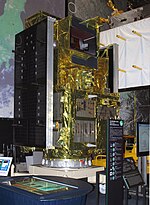 Model of GOSAT at Tsukuba Space Center Space Dome | |
| Names | Ibuki |
|---|---|
| Mission type | Environmental |
| Operator | JAXA |
| COSPAR ID | 2009-002A |
| SATCAT no. | 33492 |
| Website | global |
| Mission duration | 5 years (planned) Elapsed: 15 years, 7 months, 15 days |
| Spacecraft properties | |
| Manufacturer | Mitsubishi Electric |
| Launch mass | 1,750 kilograms (3,860 lb)[1] |
| Power | 3.8 kilowatts[1] |
| Start of mission | |
| Launch date | 23 January 2009, 03:54 UTC |
| Rocket | H-IIA-202 F15 |
| Launch site | Tanegashima, Yoshinobu 1 |
| Contractor | Mitsubishi Heavy Industries |
| Orbital parameters | |
| Reference system | Geocentric |
| Regime | Low Earth[2] |
| Perigee altitude | 674 kilometres (419 mi)[3] |
| Apogee altitude | 676 kilometres (420 mi)[3] |
| Inclination | 98.06° [3] |
| Period | 98.12 minutes[3] |
| Mean motion | 14.68[3] |
| Epoch | 25 January 2015, 03:12:11 UTC[3] |
| Main Instrument | |
| Wavelengths | 12900 - 13200 cm−1/ 5800 - 6400 cm−1/ 4800 - 5200 cm−1/ 700 - 1800 cm−1(FTS)[1] |
| Resolution | 0.2 cm−1 (FTS) |
| Instruments | |
| TANSO-FTS - Infrared Fourier Transform Spectrometer TANSO-CAI - Thermal and Near-Infrared Sensor | |
Greenhouse Gases Observing Satellite (GOSAT), also known as Ibuki (Japanese: いぶき, Hepburn: Ibuki, meaning "breath"[4]), is an Earth observation satellite and the world's first satellite dedicated to greenhouse gas monitoring.[5] It measures the densities of carbon dioxide and methane from 56,000 locations on the Earth's atmosphere.[6] The GOSAT was developed by the Japan Aerospace Exploration Agency (JAXA) and launched on 23 January 2009, from the Tanegashima Space Center.[6] Japan's Ministry of the Environment, and the National Institute for Environmental Studies (NIES) [7] use the data to track gases causing the greenhouse effect, and share the data with NASA and other international scientific organizations.[5]
- ^ a b c "Outlines of GOSAT and TANSO Sensor" (PDF). Archived from the original (PDF) on 5 February 2009. Retrieved 26 January 2009.
- ^ "Orbit Insertion of the Greenhouse Gases Observing Satellite "IBUKI" (GOSAT)" (PDF) (Press release). JAXA. Retrieved 26 January 2009.
- ^ a b c d e f "GOSAT (IBUKI) Satellite details 2009-002A NORAD 33492". N2YO.com. 25 January 2015. Retrieved 25 January 2015.
- ^ "'IBUKI' Chosen as Nickname of the Greenhouse Gases Observing Satellite (GOSAT)" (Press release). JAXA. 15 October 2008. Retrieved 29 May 2009.
- ^ a b "Japan launches rocket with greenhouse-gas probe". Associated Press. 23 January 2009. Archived from the original on 31 January 2009. Retrieved 23 January 2009.
- ^ a b Fujioka, Chisa (23 January 2009). "Japan launches satellite to monitor greenhouse gases". Reuters. Retrieved 23 January 2009.
- ^ "国立環境研究所". Nies.go.jp. Retrieved 11 April 2022.